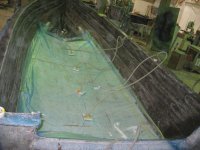The balsa core of the C-Dory line has been controversial...it is pretty-much agreed-upon that balsa coring can be a positive or a negative...
Best-practice is that when penetrating the balsa core, the balsa will be cut back under the fiberglass skins, and filled with epoxy, so that no balsa will be exposed to water even if the fitting eventually leaks water.
The cheap-assed alternative is to simply leave the balsa core exposed, but seal the fitting (thru-hulls, screws for trim tabs, etc., etc.) and just run a bead of 4200/5200 sealant under the attachment.
Does anyone know which approach the current manufacturers of C-Dory are using?
Best-practice is that when penetrating the balsa core, the balsa will be cut back under the fiberglass skins, and filled with epoxy, so that no balsa will be exposed to water even if the fitting eventually leaks water.
The cheap-assed alternative is to simply leave the balsa core exposed, but seal the fitting (thru-hulls, screws for trim tabs, etc., etc.) and just run a bead of 4200/5200 sealant under the attachment.
Does anyone know which approach the current manufacturers of C-Dory are using?

